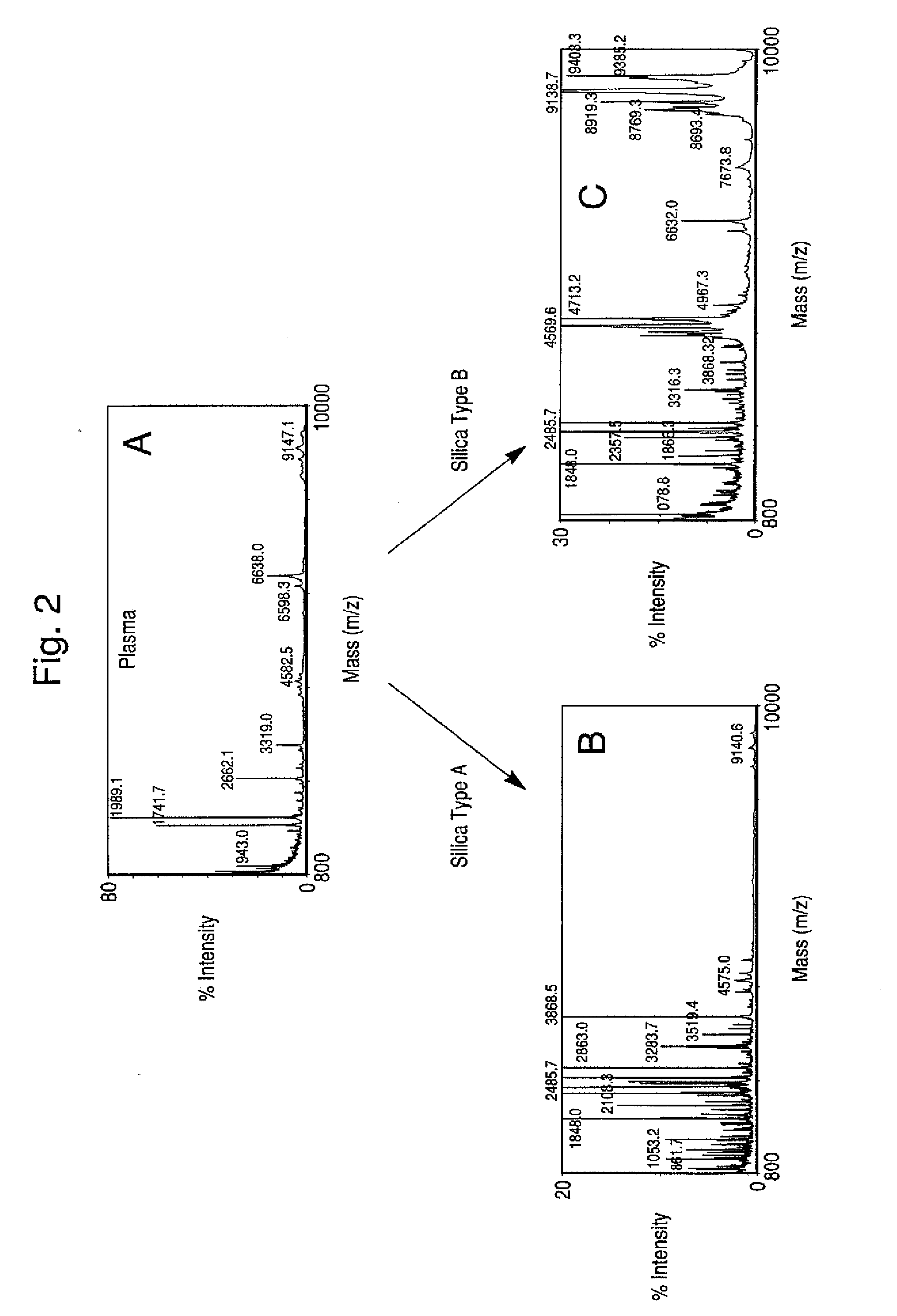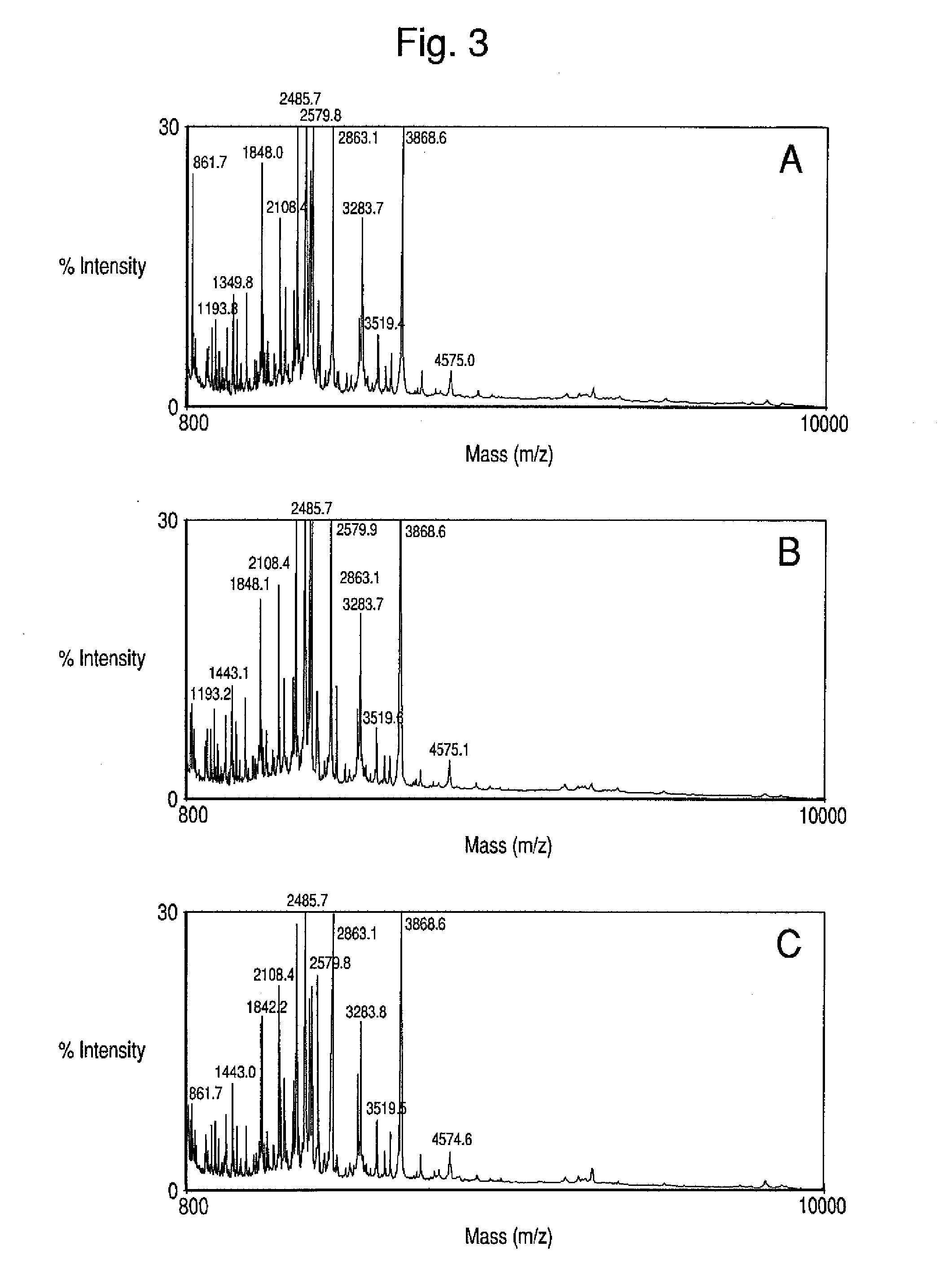Nanoporous substrates for analytical methods
a technology of nanoporous substrates and analytical methods, applied in the field of nanoporous substrates for analytical methods, can solve the problems of high-abondance substances that require expensive solutions to solve common techniques, and achieve the effect of enhancing the sensitivity of analytical instruments
- Summary
- Abstract
- Description
- Claims
- Application Information
AI Technical Summary
Benefits of technology
Problems solved by technology
Method used
Image
Examples
example 1
[0074]The citations in the brackets in this example refer to the List of References at the end of Example 1.
1. Introduction
[0075]Proteomic analysis of human plasma / serum for the early detection of cancer as well as other diseases, is an increasing area of interest for many research groups [1, 2 and references therein]. Even more attention is particularly focused on the carrier protein-bound low molecular weight molecules reputed to generate and constitute the majority of the ions that comprise distinctive MS profiles used for biomarkers discovery [3-5]. The design and the development of particles engineered to mimic carrier protein (e.g. albumin) binding and perform low molecular weight proteome (LMWP) harvesting, can therefore be of high impact in biomarker discovery [6-8].
[0076]ProteinChip Array System from Ciphergen, based on SELDI-TOF mass spectrometry, can be the most extensively used platform for the discovery of “molecular signatures” [9, 10]. Among recent technologic advance...
example 2
Fractionation of Serum Components Using Nanoporous Substrates
[0120]Numerous previously uncharacterized molecules residing within a low molecular weight circulatory proteome may provide an ongoing picture of the ongoing pathophysiology of an organism. Recently, proteomic signatures comprising low molecular weight molecules have been identified using mass spectrometry combined with bioinformatics algorithms. These demonstrations have pointed to an existence of an information archive that may contain a rich source of diagnostic information. Attempts to sequence and identify the molecules that underpin the fingerprints are currently underway. A finding that many of such low molecular weight molecules may exist bound to circulating carrier proteins may afford a new opportunity for fractionation and separation techniques prior to mass spectrometry based analysis.
[0121]Nanoporous substrates represent a new approach for the facile and reproducible fractionation and selective binding of the ...
example 3
[0174]The superscript citations in this example refer to the List of References at the end of Example 3.
Summary
[0175]The low-molecular weight region of the serum / plasma proteome (LMWP) is gaining interest as a potential source of diagnostic markers for diseases1-3. Serum LMW protein profiling4 by mass spectrometry (MS) has generally relied on surface-enhanced laser desorption / ionization time-of-flight (SELDI-TOF)5, which involves MS profiling of analytes previously adsorbed on specific chip surfaces6-9. The interference of high-molecular weight, abundant proteins present in biofluids, though, may limit sensitivity and might influence reproducibility of the analysis10. Improving selectivity of MS-based profiling by using devices allowing specific entrapment of LMW polypeptides prior to MS analysis can minimise such an interference. In this report, nanoporous surfaces were used to selectively capture LMW peptides (<15,000 Da) from human plasma. Mass spectrometry (MS) analysis of harve...
PUM
| Property | Measurement | Unit |
|---|---|---|
| pore size distribution | aaaaa | aaaaa |
| concentrations | aaaaa | aaaaa |
| pore size | aaaaa | aaaaa |
Abstract
Description
Claims
Application Information
 Login to View More
Login to View More - R&D
- Intellectual Property
- Life Sciences
- Materials
- Tech Scout
- Unparalleled Data Quality
- Higher Quality Content
- 60% Fewer Hallucinations
Browse by: Latest US Patents, China's latest patents, Technical Efficacy Thesaurus, Application Domain, Technology Topic, Popular Technical Reports.
© 2025 PatSnap. All rights reserved.Legal|Privacy policy|Modern Slavery Act Transparency Statement|Sitemap|About US| Contact US: help@patsnap.com



